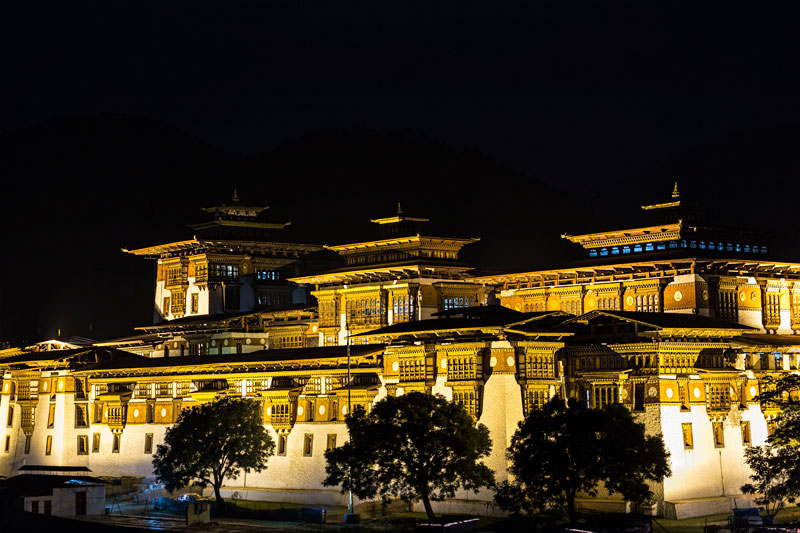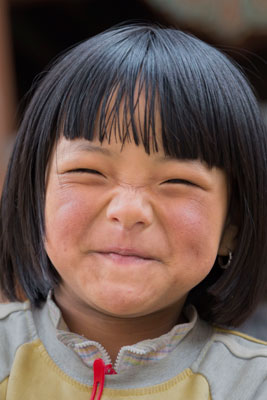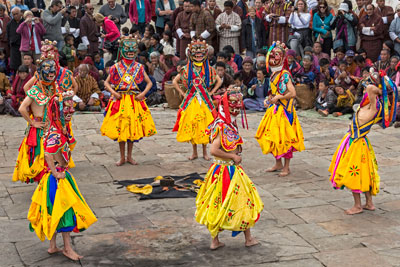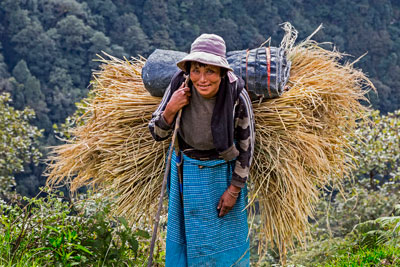Finding fabulous sights and photo ops galore on a return visit to Bhutan
This article appears on page 6 of the July 2014 issue.
Steven Emmet, Solana Beach, CA
My wife, Yuki, and I hadn’t been in Bhutan for 18 years, so in October 2013 we decided to revisit it and spend some time with friends we had made during that previous visit. After a quick email to our friend Rinzin, he said he’d take care of the arrangements.
Planning a visit
To visit Bhutan, there is a minimum fixed tariff of $250 per person (high season), which covers the cost of hotels, guides, etc. (The cost is slightly more if your “group” has only one or two people). So two people traveling for 10 days will be charged about $5,000.
To get into Bhutan, our options were to go through either India or Thailand; we chose Bangkok, where we had to wait a bit to catch our Drukair flight to Paro.
With visas in hand, we quickly cleared Customs in Paro, then Rinzin drove us on the superb highway back to Thimphu, the capital, and we were soon ensconced at the Hotel Phuntsho Pelri.
Getting around
After spending a few days seeing the sights in Thimphu, we headed back to Paro. I commented on how wonderfully straight and flat the road was, only to learn that the rest of the roads in Bhutan were, well, less than ideal. About half are paved, all are rutted and most are, at best, 1½ lanes wide, so the driver has to find a wide-enough area, without falling off a nearby cliff, to pass an oncoming car. And they all zigzag up and down the mountains with which Bhutan, being in the Himalayas, is unusually blessed.
Tunnels would be an ideal answer, but they cost a lot of money, and, other than from tourism and hydroelectric power, there are few ways for the government to earn hard currency. To put it in perspective, a 120-mile drive took us nine long hours.
I can usually sleep during a car ride, but with the bumpy sinusoidal roads, it was difficult. Having said that, we were truly amazed to see travelers bicycling up and down these bad roads, often at 10,000-plus feet!
As Rinzin remembered my dislike of long car trips, he arranged for us to fly on a 2-engine propeller plane to Bumthang, our next stop. If you’re flying east, definitely sit on the left side of the plane, as that will afford you views of some superb mountain scenery.
Bumthang
After landing in Bumthang, it was easy to spot Rinzin’s father-in-law, Mr. Gasey, as he had a Canon camera around his neck and I knew he was an avid photographer. We chatted about lenses, cameras and the like all the way back to his Jakar Village Lodge, a lovely lodge nestled in the mountains and offering great views.
When we arrived at the lodge, he made us hand-ground freshly brewed coffee. In all the rest of Bhutan, we found only “instant coffee,” so just smelling the fresh-brewed coffee brought a smile to my face.
Our room overlooked a nice river that would lull us to sleep each night. Warm futons, supplemented by a quiet but efficient heater, chased away the evening drops in temperature without any difficulty.
When I commented on the lovely wallpaper to Yuki, she said it was not wallpaper but hand painted, and she was right! Lovely Bhutanese scrolls and images covered the walls.
For Yuki and me, the best part of any trip is meeting interesting people, and this lodge’s owner was the highlight of our trip. With five minutes’ notice, Mr. Gasey could, and did, give us organized, detailed lectures on every aspect of Bhutanese culture, history, religion and politics. The icing on the cake was that he drove us to outstanding photographic points throughout the region.
After we got settled, Mr. Gasey drove us to the Ura Lhakhang Temple, where we had a nice picnic lunch.
Dinner at the lodge was superb! And I was surprised to find that access to the Internet was far faster in Bumthang than in Thimphu, which my Net guru said was because there were so many users in Thimphu and not enough broadband access.
After a really good breakfast the next day, we drove on the main road, a nice, 2-lane blacktop, for a few minutes and then turned onto a rutted dirt road, which was to be our path for the next few hours.
On our way to the Ogyen Choling Museum, we stopped to take some pictures of folks plowing a field with a wooden plow pulled by bulls as well as women cutting wheat by hand and a group of folks threshing the wheat. Several people would use pitchforks to throw the buckwheat up in the air and then eight or so others would hit it with sticks, a process they apparently continued all day long.
Finally we arrived at the museum, which had all sorts of old tools, weapons, storage boxes, pictures and the like, all belonging to one family. There was also an on-site temple.
On the way back, we stopped at Burning Lake, also called Membar Tsho. While we were there, a monk, who had somehow climbed down the rocky cliff to the river below, had set up a small table replete with a bell and prayer books and was chanting prayers, ringing the bell and burning incense.
After a day trip to Trongsa and a visit to the Royal Heritage Museum, we spent one final night in Bumthang, taking advantage of a fortuitous cancellation at the lodge.
Rinzin arrived after his 10-hour drive from Thimphu. We chatted briefly with him, had dinner and packed, as on the morrow we were to drive to Punakha.
That evening we did have a few periods of no electricity; this happened in Thimphu too.
Punakha and beyond
To go from Bumthang to Punakha, we only had to travel about 120 miles, so it should have taken about two hours, maybe 2½, right? Wrong! At least 25% of the road was dirt or macadam with large potholes, making for very slow going. With stops for lunch and photos of interesting old buildings, farmers and cute kids, it took us a very weary nine hours to reach our destination.
We finally checked in at Punakha’s Meri Puensum Resort, and it was OK but not great. The buffet was barely acceptable, and the rooms didn’t have WiFi, but this was high season in Bhutan, so every room was occupied.
After seeing some of the sights in Punakha, we returned to Thimphu, where we took a day trip to Haa, Rinzin’s birthplace. We arranged to serve the 17 or so monks at the nearby Jamtoe Temple, as this earns one a lot of spiritual brownie points.
Local interaction
A short drive later, we arrived in nearby Chumpa to challenge the locals, including some of Rinzin’s relatives, to an archery match. There was one small problem: neither Yuki nor I could pull the bowstring back on the modern, American-made compound bows we were given, even after they were loosened for us.
Using a traditional single-string, curved, bamboo bow, Yuki finally managed to send a few arrows quite close to the target, and she was pleased. They had, however, kindly moved the target from its usual 150-yard distance to a more manageable 10 yards.
We were offered the chance to stay at a “traditional farmhouse.” The Lechuna Heritage Lodge, an old, large farmhouse converted into a lodge, had spacious rooms, but guests have to commute to both the toilet and the shower. However, we were told that if we would accept twin beds, then everything would be on the same floor. As there was no one else staying there (except Rinzin), I said it would be OK. (The fact that the next town was 2½ hours away and I had no desire to be on those roads at night also had something to do with my decision.)
I was more than a bit puzzled by the reasoning behind putting sliding locks on the outside of the toilet doors. If someone should slide the bar closed, there would be no other exit from the toilet!
The room, which had a really quiet electric heater, got nice and warm — so much so that I had to kick off some of the covers. We could see the early-morning sun reflected on the snow on the mountaintops from our window.
The food here was stunningly excellent.
Then we set off for Paro, via the Chelela Pass at around 12,000 feet. Since we spent but an hour or so at the pass, we had no problems with the altitude.
Mt. Chomolhari (Jumolhari) was clearly visible. This mountain is sacred to Tibetan Buddhists, who believe it is the home of one of the Five Tsheringma Sisters, female protector goddesses of Tibet and Bhutan.
As we pulled into Paro, the airport and runway were right before our eyes. I’m sure such a vantage point would be barricaded in the US.
We enjoyed our trip to Bhutan and think you would enjoy a visit, too.





